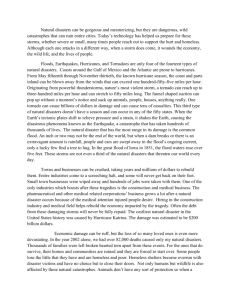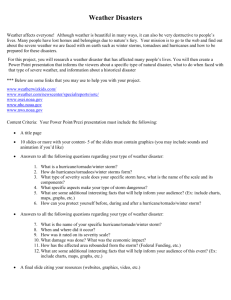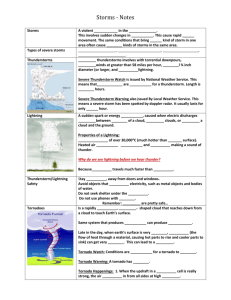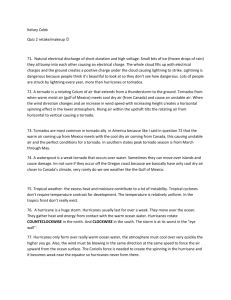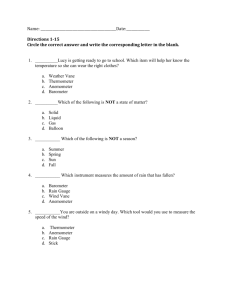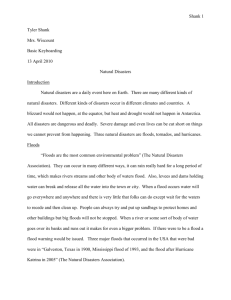natural_disasters_in_canada_activity
advertisement
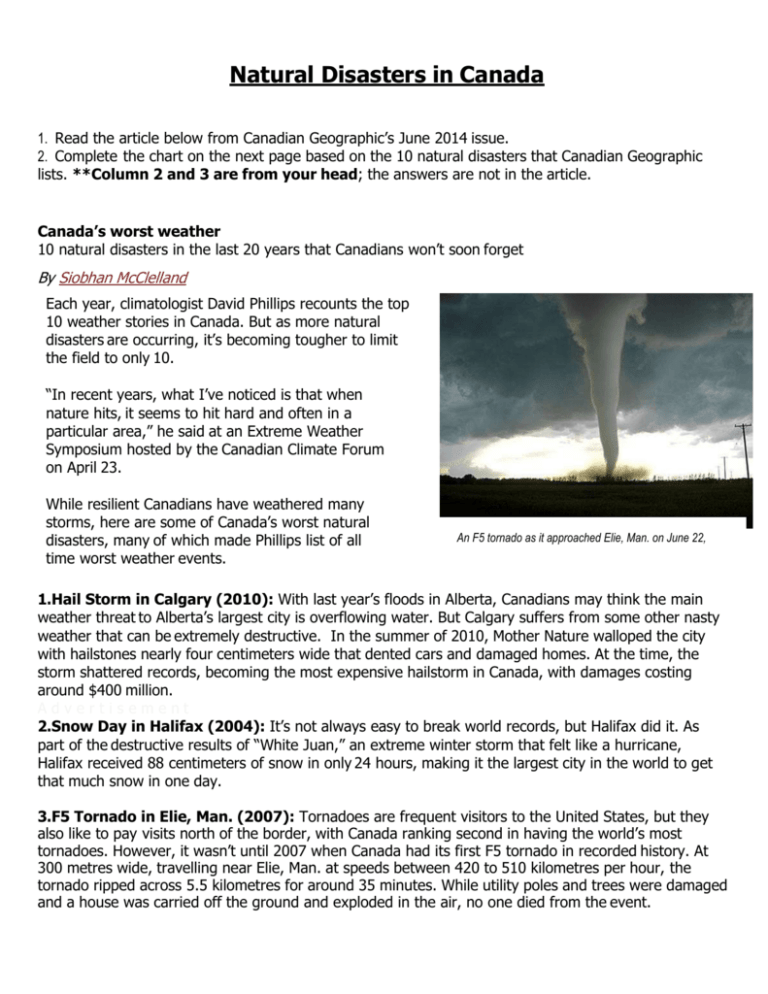
Natural Disasters in Canada 1. Read the article below from Canadian Geographic’s June 2014 issue. 2. Complete the chart on the next page based on the 10 natural disasters that Canadian Geographic lists. **Column 2 and 3 are from your head; the answers are not in the article. Canada’s worst weather 10 natural disasters in the last 20 years that Canadians won’t soon forget By Siobhan McClelland Each year, climatologist David Phillips recounts the top 10 weather stories in Canada. But as more natural disasters are occurring, it’s becoming tougher to limit the field to only 10. “In recent years, what I’ve noticed is that when nature hits, it seems to hit hard and often in a particular area,” he said at an Extreme Weather Symposium hosted by the Canadian Climate Forum on April 23. While resilient Canadians have weathered many storms, here are some of Canada’s worst natural disasters, many of which made Phillips list of all time worst weather events. An F5 tornado as it approached Elie, Man. on June 22, 2007. 1.Hail Storm in Calgary (2010): With last year’s floods in Alberta, Canadians may think the main weather threat to Alberta’s largest city is overflowing water. But Calgary suffers from some other nasty weather that can be extremely destructive. In the summer of 2010, Mother Nature walloped the city with hailstones nearly four centimeters wide that dented cars and damaged homes. At the time, the storm shattered records, becoming the most expensive hailstorm in Canada, with damages costing around $400 million. Advertisement 2.Snow Day in Halifax (2004): It’s not always easy to break world records, but Halifax did it. As part of the destructive results of “White Juan,” an extreme winter storm that felt like a hurricane, Halifax received 88 centimeters of snow in only 24 hours, making it the largest city in the world to get that much snow in one day. 3.F5 Tornado in Elie, Man. (2007): Tornadoes are frequent visitors to the United States, but they also like to pay visits north of the border, with Canada ranking second in having the world’s most tornadoes. However, it wasn’t until 2007 when Canada had its first F5 tornado in recorded history. At 300 metres wide, travelling near Elie, Man. at speeds between 420 to 510 kilometres per hour, the tornado ripped across 5.5 kilometres for around 35 minutes. While utility poles and trees were damaged and a house was carried off the ground and exploded in the air, no one died from the event. 4.Storms destroy Stanley Park (2006): Many visitors come to Vancouver specifically to see the ancient trees and beautiful totem poles of Stanley Park. But this oasis within the city was threatened by severe storms in November and December 2006 that destroyed much of the park’s natural beauty. There was extensive damage to the Seawall surrounding the park and around 41 hectares of forest were ruined. The park needed significant restoration to bring it back to its former glory. 5.Pine Lake tornado (2000): The deadly F3 tornado came crashing down in the Pine Lake area near Red Deer, Alta. There were reports of hail the size of oranges and a campground and trailer park destroyed by the twister. When the funnel clouds dispersed, 12 people were dead and more than 100 were injured. 6.Hurricane Igor in N.L. (2010): Hurricane Igor wreaked havoc on Newfoundland, with tremendous rainfall of more than 200 millimetres in one day in some areas. Bridges were washed out, houses were flooded, roofs were damaged and power was knocked out. Shortly after the storm, Prime Minister Stephen Harper toured two badly hit communities. According to The Weather Network, Harper said at the time, “I've never seen any flooding like this. I've never seen damage like this in Canada.” 7.Saguenay Flood (1996): It was the first natural disaster to cost over $1 billion and the deadliest flood since Hurricane Hazel clobbered Toronto in 1954. Torrential rains caused flooding and mudslides in the Saguenay-Lac-Saint-Jean region of Quebec in July 1996, forcing around 16,000 people to evacuate the area. Ten people died in the mudslides. There was significant property damage, with around 2,000 homes damaged or destroyed, a shopping complex swept away and cars buried in mud. 8.The ice storm (1998): A low-pressure warm front from Texas collided with a high-pressure Arctic cold front, causing freezing rain to pour down and coat much of Ontario, Quebec, New Brunswick and Nova Scotia with ice. As the ice thickened, power and telephone lines went down and millions of trees fell. The storm affected more Canadians than any previous weather event in the country. It resulted in 35 deaths, many from hypothermia, and 945 people were injured. Over 4 million people across three provinces lost power, with some not having power for more than a month. States of emergency were declared in 200 Quebec and 57 Ontario communities. 9.The drought (2000-2004): It’s not always storms that cause natural disasters. Sometimes, the lack of rain can have the most destructive consequences. Some have dubbed this drought the most severe in 800 years. It affected much of western North America, creating havoc for Prairie farmers who rely on water for their livelihood. While it didn’t last as long and wasn’t as bad in Canada, the drought had severe economic consequences for the country. It was estimated that in 2001 and 2002, agricultural production decreased by $3.6 billion. In 2002, there was no farm income in Alberta and Saskatchewan was at a loss. 10. Ice storm (2013): It wasn’t a holly, jolly Christmas for all in 2013. Vacation and last-minute holiday shopping plans were thwarted as an ice storm descended the weekend before Christmas. The storm caused ice to freeze on trees, resulting in tree branches falling on power lines, leaving thousands from Southern Ontario across to Atlantic Canada in the dark and without power. The streets turned into skating rinks, creating slippery roads for holiday travel. Disaster (Type/Place/Date) 1. 2. 3. 4. 5. 6. 7. 8. 9. 10. Possible Long-Term Impact on the Community (Use a mix of environmental, political, economic, social, etc.) 1. 2. Changes the Community Could Make to Decrease the Impact from the Same Type of Disaster in the Future (E.g. fences on a mountain to prevent avalanche?) 1. 2.

